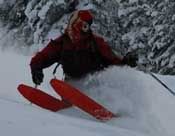full width, full length VDS rubber?
Moderators: Head Monkey, kelvin, bigKam, skidesmond, chrismp
-
Climber Joe
- Posts: 5
- Joined: Wed Mar 21, 2012 5:34 am
full width, full length VDS rubber?
Apparently the 2013 head lineup replaced titanal with full width VDS to retain dampening characteristics, at reduced weight, and retaining soft flexes. (Or at least in some of the models)
Has anyone done this? How well did it work compared to Titanal? It is proving hard to find a titanal source stateside, and if VDS dampens just as well, I like my skis snappy, so I am all for saving weight and retaining "pop."
Thanks.
Has anyone done this? How well did it work compared to Titanal? It is proving hard to find a titanal source stateside, and if VDS dampens just as well, I like my skis snappy, so I am all for saving weight and retaining "pop."
Thanks.
- MontuckyMadman
- Posts: 2395
- Joined: Fri Jun 20, 2008 9:41 pm
-
skidesmond
- Posts: 2338
- Joined: Tue Apr 07, 2009 3:26 pm
- Location: Western Mass, USA
- Contact:
I don't see titanal and VDS doing the same thing. Titanal would make a ski firmer, I don't think it will necessarily make it damp, only from the added weight perhaps. And people have done extensive tests in the forum showing that VDS doesn't really act as a dampening element but is to provide a shear layer between metal and other materials. I can see the ski being softer if they are truly replacing metal w/ rubber and I don't see rubber retaining pop.... it's rubber.
I bet VDS is cheaper than titanal.
I bet VDS is cheaper than titanal.
-
Climber Joe
- Posts: 5
- Joined: Wed Mar 21, 2012 5:34 am
Weight isn't really a concern, I want to retain a certain flex and playfulness, while adding dampness and extra delamination protection to boot.MontuckyMadman wrote:the metal is said to give added torsional stiffness and dampness from added weight.
the amount of added weight from vds top and bottom would be significant.
But just an FYI, I did a little math, and it should only add about 50 grams per pair with 0.6mm foil. Perhaps a tad closer to 100 grams, but that is still less than a quarter pound a pair.
Can anyone confirm or deny that weight estimate? I was just going off mass properties of rubber, at 945kg/m^3.
Also, one of the guys I am working with on this mentioned using a rubberized epoxy, which should add built in dampness and delam resistance without any additional layers or weight. Anybody done it?
- MontuckyMadman
- Posts: 2395
- Joined: Fri Jun 20, 2008 9:41 pm
Kingswood skis used a rubberised/toughened epoxy
HPR5 (scroll down in the link)
http://www.adhesivetechnologies.co.nz/adrseries.html
It's made in NZ so not that practical for nthn hemispherers I guess
The same company makes epoxies used in yacht construction for the America's Cup yachts
HPR5 (scroll down in the link)
http://www.adhesivetechnologies.co.nz/adrseries.html
It's made in NZ so not that practical for nthn hemispherers I guess
The same company makes epoxies used in yacht construction for the America's Cup yachts
Don't wait up, I'm off to kill Summer....
The shop I work at carrys only HEAD carving skis. I think for really getting on edge, the metal fairs better than composites or straight rubber because it makes the whole ski an even weight and flex. I have noticed that non metal skis dont feel as connected to the snow on edge.
All this to say. Rubber I don't think will have the same hold on snow that metal would (if you are carving groomers all day...).
All this to say. Rubber I don't think will have the same hold on snow that metal would (if you are carving groomers all day...).
-
Climber Joe
- Posts: 5
- Joined: Wed Mar 21, 2012 5:34 am
What I may end up doing is cutting a pattern in the rubber. Mostly along the edge, full width underfoot, with a tapered gap that gets wider toward the tip and tail, then full width at the tip and tail to help with delam protection. It shouldn't be too hard to do, just modifying the base mill pattern.
Also, and I know this is way off topic, has anyone ever experimented with anchored sidewall? I was thinking about milling a shelf into the sidewall and core so that vertical delamination would require a much more severe impact. It would only help underfoot, but that is usually where it happens.
Also, and I know this is way off topic, has anyone ever experimented with anchored sidewall? I was thinking about milling a shelf into the sidewall and core so that vertical delamination would require a much more severe impact. It would only help underfoot, but that is usually where it happens.



